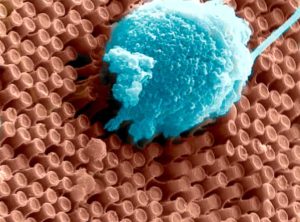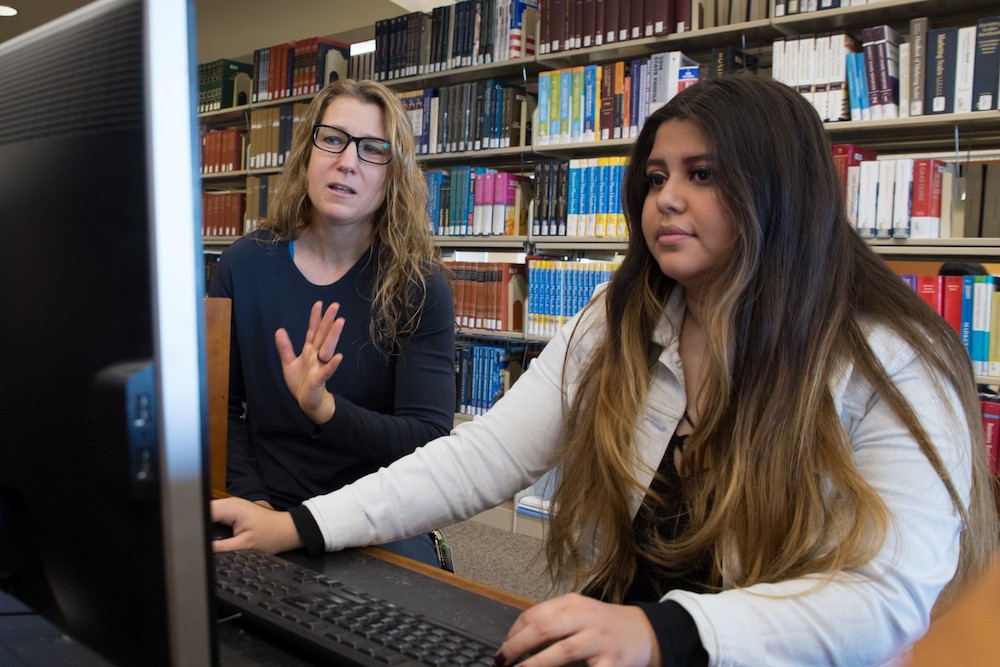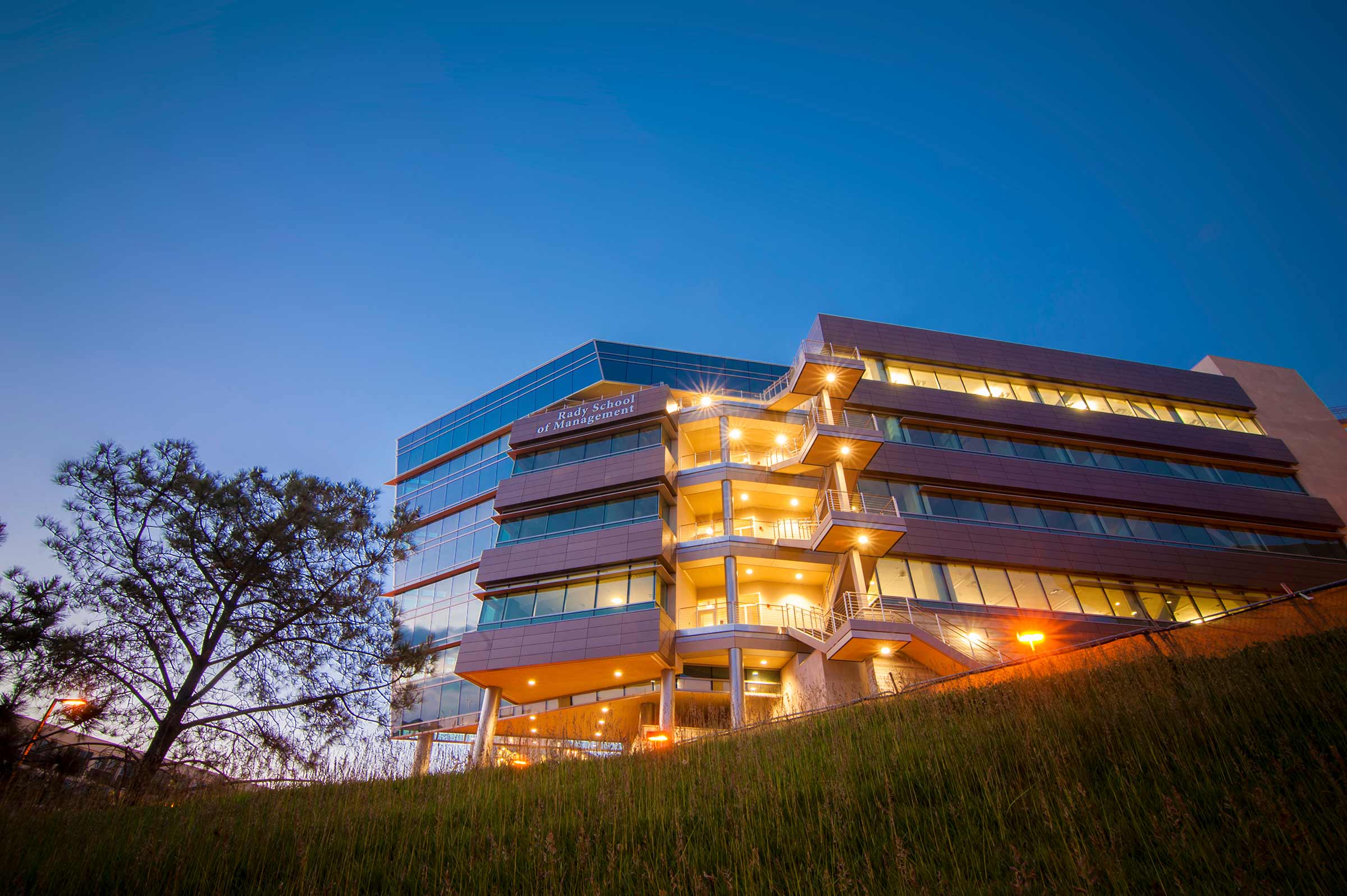Daily Business Report-March 16, 2017
Scanning electron micrograph (SEM) image of individual nanowires and groupies of nanowires. Each wire can produce an electric current when hit by light.
New Nano-Implant Could
One Day Help Restore Sight
By Ioana Patringenaru | UC San Diego News Center
A team of engineers at the University of California San Diego and La Jolla-based startup Nanovision Biosciences Inc. have developed the nanotechnology and wireless electronics for a new type of retinal prosthesis that brings research a step closer to restoring the ability of neurons in the retina to respond to light. The researchers demonstrated this response to light in a rat retina interfacing with a prototype of the device in vitro.

They detail their work in a recent issue of the Journal of Neural Engineering. The technology could help tens of millions of people worldwide suffering from neurodegenerative diseases that affect eyesight, including macular degeneration, retinitis pigmentosa and loss of vision due to diabetes.
Despite tremendous advances in the development of retinal prostheses over the past two decades, the performance of devices currently on the market to help the blind regain functional vision is still severely limited—well under the acuity threshold of 20/200 that defines legal blindness.
“We want to create a new class of devices with drastically improved capabilities to help people with impaired vision,” said Gabriel A. Silva, one of the senior authors of the work and professor in bioengineering and ophthalmology at UC San Diego. Silva also is one of the original founders of Nanovision.
The new prosthesis relies on two groundbreaking technologies. One consists of arrays of silicon nanowires that simultaneously sense light and electrically stimulate the retina accordingly. The nanowires give the prosthesis higher resolution than anything achieved by other devices—closer to the dense spacing of photoreceptors in the human retina. The other breakthrough is a wireless device that can transmit power and data to the nanowires over the same wireless link at record speed and energy efficiency.
____________________

Cal State San Marcos Library On the Front Lines of Fighting Fake News
By David Ogul | Cal State San Marcos NewsCenter
Dean Jennifer Fabbi and her staff at the Cal State San Marcos Library are on the front lines of fighting fake news.
“When I first got into this field, it was all about helping people find information,” Fabbi said. “Information was scarce and you often needed a librarian to find it. Now you have a glut of information; we’re drowning in it. But people often don’t have the skills to evaluate that information for biases and legitimacy.”
Which is why the library puts a premium on information literacy and developing student-scholars who are adept at navigating an increasingly complex landscape pockmarked with sophisticated propaganda and click bait. The goal: to provide CSUSM students with an ability to be engaged, contributing members of the communities in which they work and live.
While the focus at CSUSM is on building research skills (“One of the most important things that librarians do is work with students to evaluate sources within the context of their research questions,” says Fabbi), those skills are vital to understanding the digital information environment, including fake news.
“We want our students to be sophisticated users of information,” said Yvonne Nalani Meulemans, the library’s Head of Teaching and Learning. “We don’t want students to just Google something. We want them to be able to assess the sources and the validity of what they find.”
How bad is the current trend? The Pulitzer Prize-winning seeker of truth Politifact recently put it like this: “For those who care about accuracy and evidence, it’s time to recognize that something really has gone off course.”
Meulemans points out that too many people fail to understand the motivations behind web sources, especially those shared on social media. The trend today leans toward what many derisively refer to as clickbait.
Exhibit A is what is commonly referred to as the Stanford Study. Conducted by researchers at the Stanford Graduate School of Education and released in November, the study collected and analyzed more than 7,800 responses from students at middle schools, high schools and colleges across the country. What it found was shocking: Students too often fall prey to bogus information disseminated across social networking sites and Google searches. Most couldn’t tell the difference between a legitimate medical organization and a fringe source. And less than a third of students could articulate how the political agendas of the liberal advocacy group MoveOn.org and the Center for American Progress affected the content of a tweet by the former that linked to a study by the latter.
“These results suggest that students need further instruction in how best to navigate social media content, particularly when that content comes from a source with a clear political agenda,” the study’s authors found.
“Our ‘digital natives’ may be able to flit between Facebook and Twitter while simultaneously uploading a selfie to Instagram and texting a friend,” states the study. “But when it comes to evaluating information that flows through social media channels, they are easily duped.”
Said Meulemans: “There’s a tremendous amount of bogus information out there.”
Meulemans and Fabbi note that the University Library has launched Information Literacy Institutes that bring teachers, librarians and others from local middle and high schools to CSUSM to learn the finer points of preparing students with information literacy skills for future education and life.
“The information that is out there is so easy to access, but it can be more challenging to assess and evaluate than ever before,” Meulemans said. “I often tell students that learning to do quality research isn’t just necessary to do well in school or in your career. Understanding how information is created, shared, and used is fundamental to being part of a democratic society.”
____________________
San Diego-Based Daylight Solutions
Acquired by Leonardo DRS for $150 Million
San Diego-based Daylight Solutions Inc., a leader in mid-infrared lasers and systems based on its proprietary quantum cascade laser technologies, has been acquired by Virginia-based Leonardo DRS for $150 million.
Under the terms of the agreement, Daylight will operate as one of eight Leonardo DRS lines of business, and will maintain its current management and location in San Diego. The transaction has been constructed to be essentially transparent to Daylight’s current customers and supply chain partners. All of Daylight’s current contracts will continue to be executed without novation.
“Daylight has established itself as a market leader in scientific lasers, infrared microscopy, and lasers for aircraft survivability utilizing QCL technology,” said Timothy Day, chairman and CEO of Daylight Solutions. “Together with the added strength of the people and resources of Leonardo DRS, the mission of Daylight Solutions, ‘To Protect with Light,’ will be more fully realized and will enhance our proven ability to transition new technologies into commercial products for a wide range of industries.”
All three co-founders, Timothy Day, Paul Larson, and Sam Crivello, will remain with Leonardo DRS.
____________________
Northrop Grumman to Provide Advanced
Targeting Pods to Royal Danish Air Force
Northrop Grumman Corporation has been awarded a contract by the Royal Danish Air Force to provide LITENING advanced targeting pods for its F-16 aircraft. LITENING gives pilots powerful capabilities for detecting, identifying and tracking targets at extremely long ranges.
Denmark was the first international partner to take delivery of the fourth generation of the LITENING pod. With this award, the RDAF will expand the use of LITENING to additional aircraft in its fleet.
“As a key member of NATO, Denmark supports a wide range of missions. LITENING gives the RDAF powerful capabilities to carry out these missions, whether they call for targeting or intelligence, surveillance and reconnaissance,” saidRobert Fleming, a Northrop Grumman vice president.
The Northrop Grumman LITENING Advanced Targeting System, now in its fourth generation, gives aircrews superior situational awareness and targeting capabilities for strike and ISR missions. Technologies include digital, high definition video, 1K forward-looking infrared and charge-coupled device sensors, laser imaging sensors and advanced data links.
____________________
USD’s SOLES Ranked Among
Top 10 Percent of Schools in Nation
U.S. News & World Report has listed the University of San Diego’s School of Leadership and Education Sciences (SOLES) among the nation’s top 10 percent of Graduate Schools of Education for the fourth year in a row.
SOLES’ top tier ranking has continued to rise over the past several years, reaching No. 89, up from last year’s 93 in the 2018 U.S. News and World “Best Graduate Education Programs” report.
SOLES was founded in 1962 and is the second oldest academic unit at the University of San Diego. SOLES has three departments offering graduate programs: Counseling and Marital and Family Therapy, Leadership Studies, and Learning and Teaching, offering 6 M.A. specializations, 8 MEd specializations, including an online degree, and 1 Ph.D. program. The three graduate departments within SOLES are held to the highest standards, established by each of the department’s accrediting bodies.
____________________
Balboa Park Event to Give Hands-On
Training to Young Tree Stewards
The Balboa Park Conservancy, in partnership with the city of San Diego Park & Recreation Department, is planting 21 new trees around Morley Field Dog Park on Balboa Park’s east mesa this month as part of its ongoing efforts to diversify and augment the park’s urban forest. The planting will also provide a hands-on training opportunity for young tree stewards participating in a unique Tree San Diego certification program.
The planting of 14 jacarandas and seven Torrey pines, donated by The Village Garden Club of La Jolla, Jacaranda Project, will take place on March 22. The following day, March 23, fifth graders from Chollas Meade Elementary School will be trained by experts from Tree San Diego in the watering and care of new and mature trees as part of its San Diego Junior Tree Steward Certification program.
The tree steward certification program, funded in part by a grant from Cliff and Carolyn Colwell through The San Diego Foundation, will engage more than 100 youth to become tree caretakers and to promote the importance of healthy trees in every San Diego neighborhood, particularly those needing more trees.
“Having lost more than 50 trees since the beginning of the year due to winter storms, on top of a massive die-off caused by five years of drought, the Conservancy is determined to reverse the trend by planting more trees in Balboa Park each year,” said Balboa Park Conservancy President and CEO Tomás Herrera-Mishler. “I am very grateful to San Diego’s Park & Recreation staff and our many partners and funders who will enable us to make our beloved Balboa Park much shadier in the years to come.”



